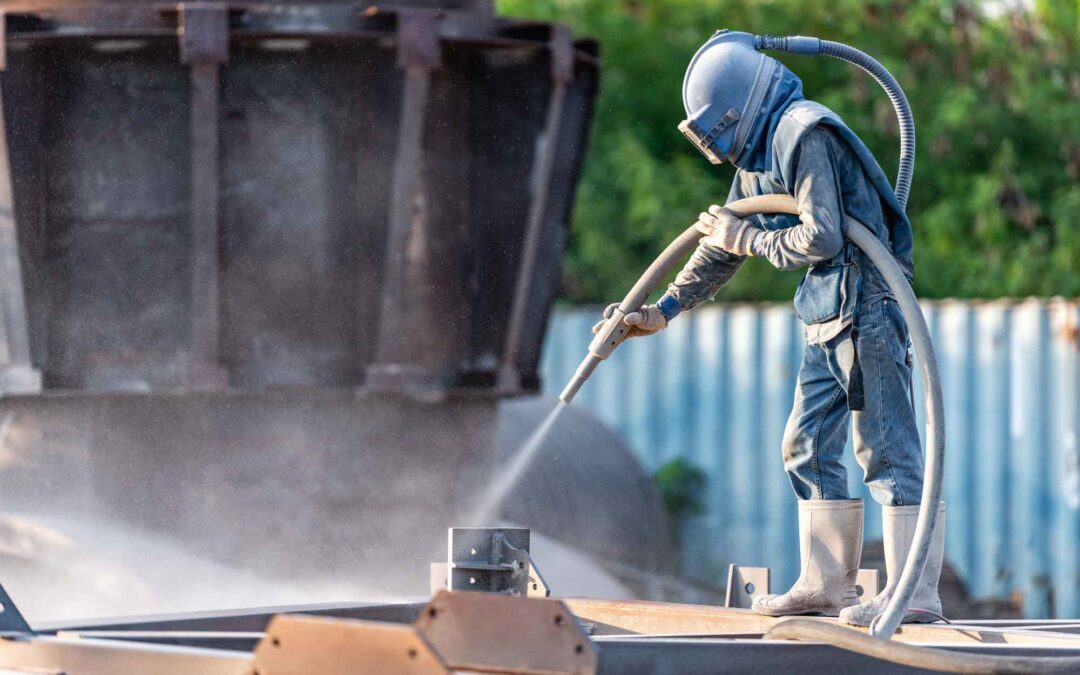If you’re preparing for a surface preparation and cleaning project, it’s only natural to want it to be as environmentally friendly and as efficient as possible. That’s why the term “dustless blasting” has gained traction.
But is dustless blasting really dustless? Unfortunately, that term is misleading. All abrasive blasting equipment produces some dust.
This article will explain why the correct term for this process is “wet abrasive blasting” and its advantages for surface preparation.
What is wet abrasive blasting?
Wet abrasive blasting is a blasting process that removes coatings, residues, contaminants, and corrosion from a variety of surfaces.
Also called vapor abrasive blasting, wet abrasive blasting differs from dry sand blasting in that it involves the use of water and an abrasive. You might look at it as a hybrid of sand blasting and power washing a surface, but with much greater efficiencies – less material and less water will get used with this process vs. using a dedicated sand blaster or power washer.
The main benefit of the wet abrasive blasting method over traditional sand blasting is that it creates dramatically less dust. Less dust reduces containment set-up and clean-up time and a surface that has far fewer clinging or embedded dust particles, saving time and money.
Here are some other advantages of wet abrasive blasting over dry blasting:
- It also provides a safer environment with less particulate matter in the air.
- Workers can wear more comfortable and lightweight protective gear.
- The moisture helps keep surfaces cooler, preventing metal warping and stretching.
- It is effective on sensitive surfaces.
How much dust occurs in wet abrasive blasting?
As we have stated, there is no such thing as a completely dust-free surface preparation method. All abrasive blasting techniques produce some dust. However, air quality tests show that wet abrasive blasting produces as much as 92 percent less dust than dry sand blasting.
Here’s why. During dry sand blasting, a stream of highly pressurized air is used to direct abrasive material toward the surface. When the particles hit the surface at a high velocity, they shatter into millions of fine particles. Most of these tiny particles remain suspended in the air for a while before descending to the ground.
With wet blasting, the abrasive particles are encased with water. When the particles hit the object surface tension holds them in place, preventing most of them from bouncing off into the air.
Some of the tiny particles may escape contact with the water or be so light that the water cannot weigh them down. Although the dust level is far less than with traditional dry blasting, these “escaped” particles can cause some dust during wet abrasive blasting.
Why you need to know the truth about so-called dustless blasting
Knowing the facts about wet abrasive blasting is critical because misconceptions can be costly.
For example, if a company thinks a blasting project will be completely dustless, it might cut corners on air quality control or safety measures. The reality is that any abrasive particulate matter can pose a health concern.
According to the Occupational Safety and Health Administration (OSHA), abrasive blasting operations can create noise and toxic materials that pose hazards to workers. Of particular concern is silica dust, which can cause silicosis, a disease that affects the lungs and is the cause of over 100 deaths in the U.S. each year. In 2016, OSHA implemented new silica regulations to help reduce worker exposure to respirable crystalline silica.
Although wet blasting is a great start for reducing job site dust conditions, government regulations do not distinguish between wet or dry blasting methods. In order to abide by the rules and keep their workers safe, contractors must provide proper personal protective equipment (PPE) to all workers. This equipment includes:
- Respirators
- Hearing protection
- Blast suits
- Face shields
- Eye protection
- Gloves and boots
Don’t believe the myths about dustless blasting. Remember, all blasting methods produce dust.


